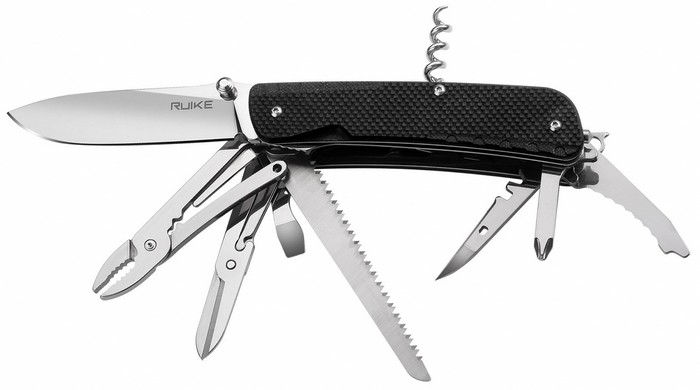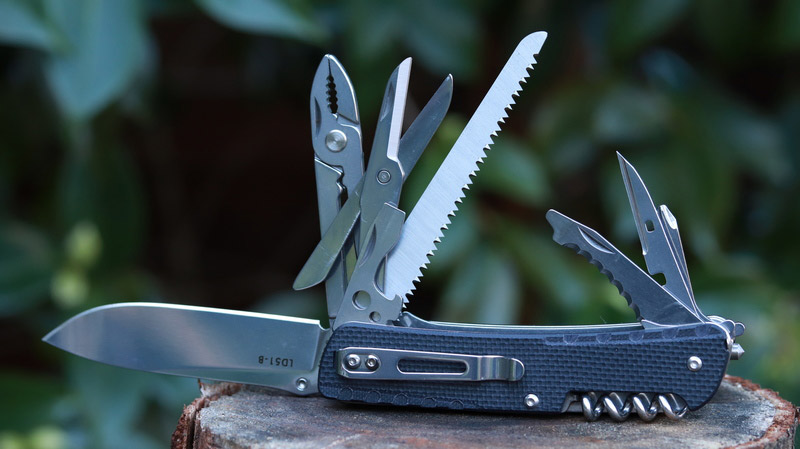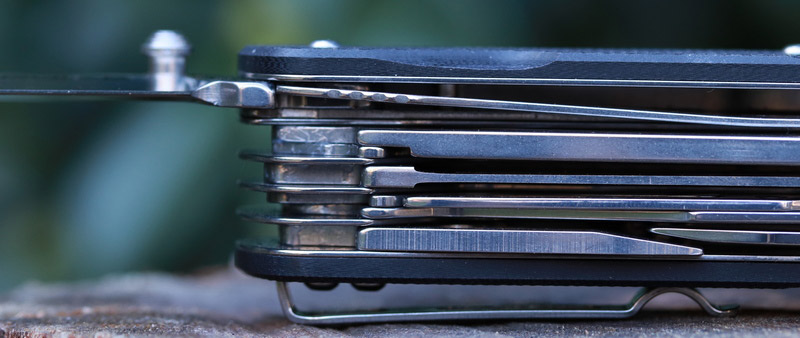We independently evaluate all recommended products and services. Any products or services put forward appear in no particular order. If you click on links we provide, we may receive compensation.
Ruike is a relative new-comer to the budget and mid-priced knife market. They are quickly earning a reputation for high value folding knives, so much so that Boker has outsourced with them to produce their Tech-Tools line of multi-function knives in the traditional Swiss Army style. Ruike also produces their own versions of these knives in a multitude of configurations. Today we will be looking at the LD-51 from Ruike’s full size Trekker series.

Key Specs: Ruike LD-51 Trekker
The Ruike Trekker LD-51 is a full sized, five layer Swiss style tool with an impressive 23 tools. Just like every multi-function knife Ruike offers, it has textured G10 scales for a much more positive grip than its Swiss style competition. Plus, with a body that is an inch longer than the standard Victorinox tool, it fills the hand much better and allows for bigger, more useful tools to be included.

While you do not get the sheer number of functions that the biggest, most dense multi-tools offer, the proper blade, superb saw, and excellent scissors all put to shame the ones found on such offerings. Additionally, the LD-51 sneaks in a corkscrew and tweezers that are rarely included in smaller Swiss and folding stile multi-function tools.
LD-51 Tool Set
The Ruike Trekker LD-51’s tool-set as listed by the manufacture includes 23 features:
- Large Blade – 3.3 inches of 12C27 Sandvik stainless steel
- Pliers – These pliers are smaller and more rounded than the pliers found on most full size multi-tools. They do not provide as good a grip and tend to wear on the items being turned, but they will get the job done most of the time.
- Wire cutter
- Fishing line pliers
- Scissors – These are among the best spring loaded scissors that can be found on a multi-tool. They cut exceptionally well and are a size larger than can be found elsewhere.
- Wire bender
- Bottle opener – There is no can-opener on this tool.
- Large flat head 6.5mm screwdriver.
- Wire stripper/bender.
- Wood Saw – This excellent 4 inch double row wood saw is a full inch longer than the three inch saws found on most other multi-tools. Plus, inch for inch, it cuts as well as the best of them.
- Facer – Although useful in some situations, the edge here makes opening the tool a bit tricky as it covers most of the area you would grab to lift the tool.
- Awl – This and the Philips bit are a bit challenging to deploy as you must deploy a tool opposite of them to make room and then use their stiff flipper tabs to deploy them.
- Wire stripper
- Spoke wrench
- Reamer with sewing eye
- Philips Screwdriver – This is clearly a step up from a two dimensional flat head bit found on many multi-function knives as it works well on new Philips head screws. However, it is still is not ideal for turning worn or partially stripped screw heads as the teeth are not all that deep.
- Belt cutter – This tool opens to a 45 degree angle, and with a tooth pattern different than the dedicated saw, it gives a solid second option to cut various materials.
- Small flat head screwdriver – This second, smaller flat head screwdriver here is almost useless. The tip is rounded and at a 45 degree angle to the tool. On top of that, it sits at the end of a saw that does not lock and rests above your fingers as you grip the Trekker. This is needlessly dangerous design, and its use should be avoided if possible.
- Pocket clip – The clip is located in a poor spot for pocket carry as it holds the LD-51 in its second widest dimension in the pocket. A better spot might have been on the back locking side to keep a slimmer profile in the pocket.
- Corkscrew – The wine bottle opener works flawlessly, though it does protrude slightly outside of the frame while folded.
- Glass breaker
- Lanyard loop
- Tweezers – These tweezers have more flex than I would like, but with some effort still work quite well.
The Blade
The 3.3 inch high, saber grind, drop point blade is made of Sandvik 12C27 and features a single thumb stud positioned for one handed, right hand opening. The real selling point of the LD-51 is that it has a liner lock on the main cutting blade, a feature found very rarely on multi-tools of any kind. Out of the box, the blade was moderately sharp and would easily cut paper, however it was not shaving sharp as it would only cut arm hair with a very steep angle and somewhat heavy pressure. Despite the short belly, the blade slices quite well as the blade stock is not overly thick.
The long narrow profile makes food prep a snap, especially spreading condiments. It will also tackle small outdoor tasks with ease. The thumb ramp, textured G10, and hand-filling handle make wood working easier than with other multi-tools. This combination allows for great leverage on tasks such as carving notches and making feather sticks.

Edge retention is in line with other Swiss style multi-function knives. Sandvik 12C27 is reportedly very similar to the steel used in Victorinox knives, and also boasts excellent corrosion resistance. That is to say, it holds its edge in line with budget steels like 8Cr13MoV. While this is a compromise compared to the blade on a dedicated $70 folding knife with a true mid-range steel like Sandvik 14C28N or VG-10, it is in line with most all of its competition.
Sharpening the LD-51 will be easy with traditional hones or rod sharpening systems as the blade features a sharpening choil and a long straight blade. Although there is a long flat on the top portion of the blade that would normally be ideal for clamping style continuous angle sharpening systems, the fact that the blade is on the outside of a wide heavy tool makes it very clumsy to use on one. These systems require constant flipping of the knife, and although it is certainly possible, the process just feels awkward when applied here.
Deployment
Deployment of the knife blade is unassisted and requires more force than most folding knives and catches in a few spots as it travels. However, with a vigorous wrist flick the knife will deploy without trouble. Lock up is good, but there is a little play in all four directions. Most of the tools on the Trekker deploy more in line with the tools found on other multi-tools, with focused two handed effort. The tools move smoothly enough, but as with the knife blade the locking surfaces are rounded over squares, so they catch at one or two points in their travel.

Most of these tools are deployed by the use of a nail nick. However the awl and Philips head screw driver deploy with a flipper tab, and the saw and corkscrew both flip out by lifting under their ends. These all work practically enough, but they just do not have the buttery smoothness Victorinox products are famous for. That said, they all work much easier than the typical knock off multi-tools that are far better at abusing finger nails than actually deploying their tools. Lock up on most of these tools is quite good for slip joint tools. They have a very strong spring, and the square locking surfaces that hinder deployment make the lock up better than on most Victorinox tools.
Handle and Ergonomics
Let’s get this out of the way: the Ruike Trekker is a brick in the hand. Though to be fair most large multi-tools are. The liners are all steel making for a very strong but heavy tool. In contrast, Victorinox products save some weight by using aluminum to great effect. The four inch handle, with it’s almost square profile, is similar in diameter to a full size hand tool like a hammer or saw, and grips well for it.

During hard use, there are some hot spots around the edges of the G10 scales as they are not particularly well rounded over. The tip down only pocket clip is also a hot spot when using the larger tools as they are all located on the same end of the Trekker as the pocket clip. Though to be fair, the vast majority of multi-tools are a mess of right angles, slick surfaces, and exposed steel edges. Fitting the maximum amount of functions into a portable tool comes with real compromises, and creature comfort is almost always the first to go. With that in mind the Trekker is still more comfortable in hand than the vast majority of its competition.
As stated several times already in this review, the Trekker shines over its competition in that it has textured G10 scales with cut outs around the edges for enhanced grip. Most multi-tools use smooth scales or bare steel that can be unwieldy with wet hands. The Trekker on the other hand is secure in most any condition.
Pocket Manners
The Trekker is too wide and heavy for easy pocket carry. That is to say, it is more suited for a belt, bag, or glove box. At nearly 10 ounces, and a wide 10 ounces at that, it just feels ponderous in your pocket as you go about your day. The tip down only pocket clip forces the tool to sit in the pocket in its second widest orientation. While you can rotate the Trekker in your pocket so that it sits with the wide back to your body, it rarely stays flat. Your pants pull the LD-51 around so that the corner is pushing into your leg as you walk.
I feel that having the clip tip up and mounted on the back of the tool might have been a more ideal placement. It would ride more flat to the body and eliminate a hot spot all at once. That said, tucked into a belt pouch, or more ideally in the pocket of a bag, this tool carries as well if not better than a full size multi-tool.
Fit and Finish
The fit and finish on the Trekker is generally quite impressive. The tools all have a beautiful, near mirror polish. The logos are all crisp and black. My favorite aesthetic touch is the stone wash on the slip joint springs. It has a wonderful warm finish to it, and it gives a beautiful contrast to the mirror finish on the tools. Despite these attractive touches, trouble comes in with the brick pattern on the G10.

I will stand behind the textured G10 being the single best feature of this multi-function tool, however it is the same texture found on many low-end folding knives. It adds wonderful grip to the knife, but it just looks a little sloppy and out of place with its ill-defined edges. All together, at a price point of $70 street, there is a lot of polish on the LD-51, and it is a handsome tool.
Competitive Offerings
All these knives available at BladeHQ.
 Victorinox Ranger Grip 179 ~$70 – The Ranger Grip 179 features a serrated 3.3 inch locking blade with one handed operation. It is only 3 layers with 12 tools, so it has fewer uses than the Trekker. However, it is one of the few four inch framed alternatives. It features rubberized grip inserts and a more ergonomic shape than the Trekker, and it weighs in at just 6 ounces. Even though it would be more ideal for pocket carry with the narrower handle and light weight, it does not have a pocket clip.
Victorinox Ranger Grip 179 ~$70 – The Ranger Grip 179 features a serrated 3.3 inch locking blade with one handed operation. It is only 3 layers with 12 tools, so it has fewer uses than the Trekker. However, it is one of the few four inch framed alternatives. It features rubberized grip inserts and a more ergonomic shape than the Trekker, and it weighs in at just 6 ounces. Even though it would be more ideal for pocket carry with the narrower handle and light weight, it does not have a pocket clip.
 Victorinox Hercules ~$85 – The 4 inch Hercules has 18 tools, uses aluminum spacers, and comes in 2 ounces lighter than the Trekker. Its tools are smoother to deploy, and it has a can opener and a few extra (and slightly better) screw drivers on board. Unfortunately, the scissors are smaller and harder to use, and its smooth plastic scales lack the all-star textured grip of the Trekker. Worst of all, the locking 3.3” blade opens only with a nail nick.
Victorinox Hercules ~$85 – The 4 inch Hercules has 18 tools, uses aluminum spacers, and comes in 2 ounces lighter than the Trekker. Its tools are smoother to deploy, and it has a can opener and a few extra (and slightly better) screw drivers on board. Unfortunately, the scissors are smaller and harder to use, and its smooth plastic scales lack the all-star textured grip of the Trekker. Worst of all, the locking 3.3” blade opens only with a nail nick.
 Trekker LD42 ~$60 – The 4 layer LD-42 model features 19 functions, but it omits the pliers and Philips driver included in the LD-51. Doing so concentrates on the things the Trekker line does better than other multi-tools, namely the long saw and knife and exceptional scissors. While less well rounded by itself, this makes for a slightly less ungainly knife in pocket. It could also pair with a purposely chosen pliers based multi-tool to give you access to the tools they both do best. This has the potential to be an ideal two-piece, portable tool system for a car or backpack.
Trekker LD42 ~$60 – The 4 layer LD-42 model features 19 functions, but it omits the pliers and Philips driver included in the LD-51. Doing so concentrates on the things the Trekker line does better than other multi-tools, namely the long saw and knife and exceptional scissors. While less well rounded by itself, this makes for a slightly less ungainly knife in pocket. It could also pair with a purposely chosen pliers based multi-tool to give you access to the tools they both do best. This has the potential to be an ideal two-piece, portable tool system for a car or backpack.
 Boker Plus Tech Tool City 4 ~$60 – The Boker Plus Tech-Tool City 4 is a slightly scaled down 3 inch version of the Trekker. It has a non-locking 2.8 inch blade accessed with a nail nick. It boasts tip up or down right handed carry as it has additional drilled and tapped holes for the pocket clip. It also has handsome polished G10 scales look fantastic but diminishes the tool’s traction.
Boker Plus Tech Tool City 4 ~$60 – The Boker Plus Tech-Tool City 4 is a slightly scaled down 3 inch version of the Trekker. It has a non-locking 2.8 inch blade accessed with a nail nick. It boasts tip up or down right handed carry as it has additional drilled and tapped holes for the pocket clip. It also has handsome polished G10 scales look fantastic but diminishes the tool’s traction.
 Leatherman Super Tool 300 ~$80 – The Leatherman Super Tool 300 is the quintessential pliers based multi-tool. In the same 9 ounces, it features 19 functions including pliers, ruler, wire cutters (with changeable blades), and a file that far exceed the others in this roundup. The blade, however, is only 420HC. While it is very resistant to out-right abuse, its edge retention seems to fall behind the others listed here. The fit and finish is also the most tool-like seen here. It is functional to be sure, but there are the far more imperfections then on the Swiss style tools listed above.
Leatherman Super Tool 300 ~$80 – The Leatherman Super Tool 300 is the quintessential pliers based multi-tool. In the same 9 ounces, it features 19 functions including pliers, ruler, wire cutters (with changeable blades), and a file that far exceed the others in this roundup. The blade, however, is only 420HC. While it is very resistant to out-right abuse, its edge retention seems to fall behind the others listed here. The fit and finish is also the most tool-like seen here. It is functional to be sure, but there are the far more imperfections then on the Swiss style tools listed above.
Conclusions
The Ruike Trekker LD-51 has proved to be a step forward for Swiss style multi-function tools. It addresses a few of their biggest shortcomings with well-textured scales and a full size locking blade that is accessible with one hand. There are clearly a few compromises, but that is a frustratingly universal issue with all forms of multi-tools.
Of course, one has to make real sacrifices to force the utility of a cluttered tool box into a single gadget. The big LD-51 with it’s 23 functions might be better suited for belt, glove box, or pack carry than for the pocket. Fortunately, there are many slimmer options in Ruike’s Trekker lineup that would make for perfectly acceptable EDC. In summary, the Trekker LD-51 packs many very usable tools into an easy to use package and fills the gap nicely between a Swiss Style knife and a folding multi-tool.
- Well made, packed with features, reasonable price
- Just too big for the pocket
Ruike LD-51 Trekker
Quality/Performance - 62%
Value for Money - 76%
69%
Decent attempt by Ruike at the Swiss Army/Multi-Tool market. Packs a ton of functionality but at the expense of size and weight.
Review by Seth Gunn





